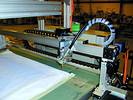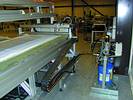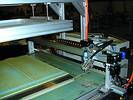Airbag leader ramps up for emerging 'curtain bag' market with the aid of novel CAD-to-motion tool
1 October 2003

A new tool that generates motion control paths directly from CAD drawings is helping the leading airbag manufacturer, Automotive Safety Components International to ramp up production for the fast-growing curtain-bag market.
To protect automobile occupants in roll-over conditions, the curtain bags that cover the side window areas must stay inflated for longer than a standard airbag. Automotive Safety Components International (ASCI) achieves this by adding glue to the seam stitching. With demand for curtain safety accessories beginning to escalate, ASCI initiated a development project to automate the gluing process. Developing the applicator mechanism was relatively easy, but ASCI also wanted the machine to operate directly from the CAD drawings of airbags provided by automobile manufacturers.
The motion control supplier Baldor provided a solution in the form of a new toolkit called MintNC. This PC-based environment imports information in industry-standard CAD formats - including G-code, HPGL and DXF - and generates the required realtime motion commands. In this instance, the package imports an airbag drawing, runs an optimisation script to turn the drawing lines into a time and movement efficient path, and then streams the resulting motion commands to the motion controller.
The realtime motion control system that controls glue application, consists of a NextMovePCI motion controller card plugged into the expansion bus of the host PC, connected to three FlexDrives and three BSM servo motors that control X-Y-Z axis movement. In operation, two laser-cut halves of an airbag - one on top of the other - move into the machine, and the Z axis comes down and vacuum-lifts one half into the air. The glue gun mounted on the X-Y axes then moves in and deposits a 4 mm-wide bead of glue around the edge of the bottom half. The Z axis then drops back down and compresses the pieces together to create the join, and the glued bag moves along to the sewing stage of the process.

The new machine is a prototype, and performs a dual role for ASCI. It provides the means to automate the sampling process, allowing curtain bags to be produced automatically from a design drawing - providing a service that allows ASCI's automobile customers to evaluate and optimise their designs extremely rapidly. It also speeds production, allowing the gluing process for these very large airbags to be performed in typically seven minutes. This provides an efficient platform for both the manufacturing quantities required today, and the expected progression of curtain bag technology from the luxury to the mass-market vehicle sector. ASCI is now developing the machine concept to provide its sister production sites around the world with automation for mass-volume production.
Baldor provided the motion control subsystem used in the machine, and worked on-site with ASCI to develop and optimise the control software. The software for the realtime motion control system was simplified by means of multitasking facilities built into the MintMT motion language used in application. This allowed the control program to be broken down into a number of small individual tasks, such as homing the axes, controlling Z axis movement, controlling the glue-laying X-Y axes, and collision detection algorithms and other tasks associated with machine safety. Some of these tasks run in the background, while others are called as required by MintNC's event-driven scripting environment. The human-machine interface to the machine was created as part of the front-end MintNC process.

The entire motion control subsystem was produced and optimised by Baldor in around a month. The overall machine was developed and commissioned by ASCI in just over four months.
"No off-the-shelf machinery existed for this application. The MintNC toolkit allowed us to create a custom automation solution quickly and economically," says Eddie Hood, the development engineer at ASCI responsible for the machine. "Without it, we would have been faced with a major custom software project that would probably have added tens of thousands of Euros in additional cost, and months to project timescales."
"If you have any kind of unusual contouring or profiling application, manufacturers are often faced with the prospect of adapting their process in order to use a standard machine - or the time-consuming task of building a custom automation solution from scratch," says Tony Collins of Baldor. "This toolkit provided ASCI with the building blocks to rapidly assemble motion machinery to suit its production needs exactly."
For further information contact Mark Crocker of Baldor on mark.crocker@baldor.co.uk
Others who read this also read these articles
A challenge for motor manufacturers
Computer-based integration of design and manufacturing is essential for the '24-month car' to be achieved[ October 2004 ]
Prominent new lifestyle centre for Cape Town's financial district
Dimension Modeling created the 3D interior models that were then also rendered out for internal views of the apartments as well as the atrium and foyer areas[ August 2004 ]
Anglo Platinum - automating repetitive design tasks with Solid Edge
Solid Edge Insight is an innovative solution that seamlessly integrates CAD, design management and Web-based collaboration into a single tool that is easy to implement and easy to manage[ June 2004 ]
Styled plastic products and packaging - main pains and solution initiatives
To put the product and the customer front and centre, where they belong, all disciplines must sit at the same virtual table, sharing the same information and seeing the same vision[ June 2004 ]
Evolution from 2D to 3D - a product development manager's perspective: Part II
Whereas 2D CAD shortens time scales to some extent, 3D CAD goes much further, directly supporting the whole product development cycle, speeding up every activity and increasing the quality of design by removing many sources of inaccuracy and error[ April 2004 ]
Multiphysics analysis to simulate cylinder head
Adiabatics Inc used multiphysics FEA software from Algor to study the thermal and structural behaviour of a cylinder head for a diesel engine that would provide reduced heat rejection and increased power density while maintaining its superior fuel economy and lower operating cost[ December 2003 ]
Unigraphics NX 2: the next generation
What the NX 2 release sees is the integration of the use of networks of curves to define surface boundaries and existing geometry, and freeform surface modelling into the core of Unigraphics but with a few rather neat extras as well[ October 2003 ]
Geopak helps create Festival City
Geopak Site allows one to handle with ease live 'what if' scenarios with the client and other design team members[ August 2003 ]
Others who read this also read these news items
Lockheed Martin selects preferred MCAD tool
[ December 2005 ]
Grand scale initiatives at Ethekwini Municipality
[ October 2005 ]
Robert Mugabe Avenue in Windhoek gets extension
[ August 2005 ]
Strand7 nonlinear analysis used to solve bracket deformation problem
[ August 2005 ]
Scania optimises truck components
[ February 2005 ]
Delcam's PowerMILL chosen for A1 Grand Prix engine manufacture by Zytek
[ February 2005 ]
A first of its kind: irrigation development, a R3,7-billion SADC project
[ February 2005 ]
Arup lands Tianjin Olympic Aquatic Centre project
[ December 2004 ]
Others who read this also read these regulars
Search Site
Subscribe
Previous Issues
Other Technews Publications
Other Technews Buyers Guides
 |  | Copyright c1995-2009 Technews Publishing (Pty) Ltd.. All rights reserved. |